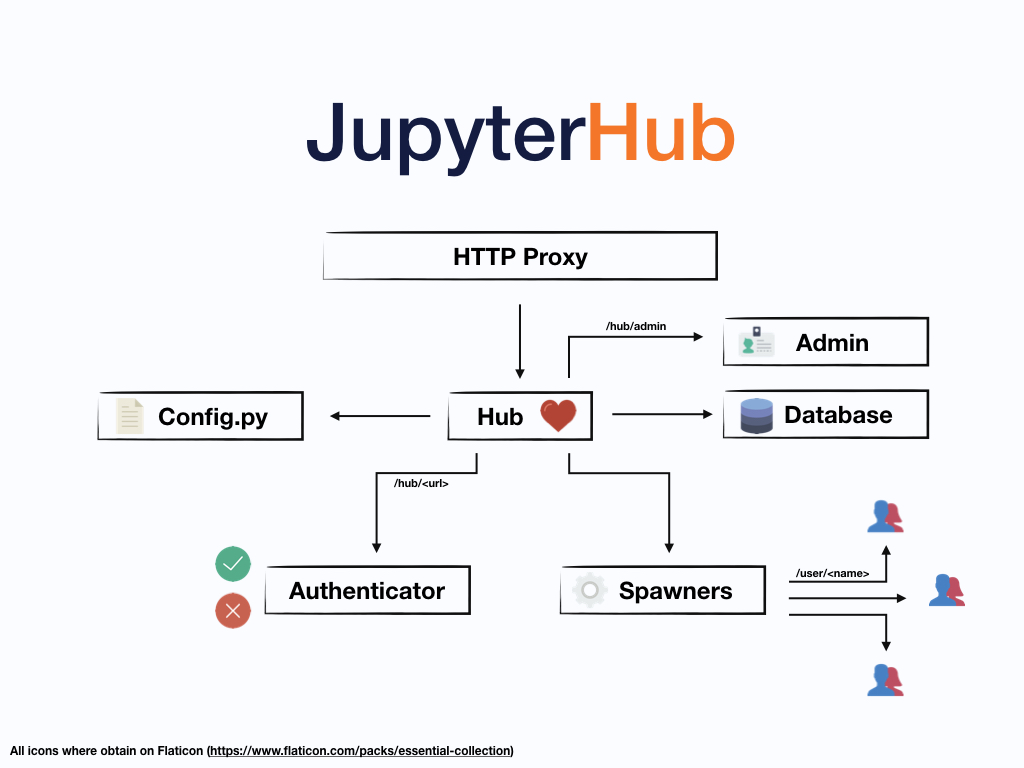JupyterHub#
JupyterHub is the best way to serve Jupyter notebook for multiple users. Because JupyterHub manages a separate Jupyter environment for each user, it can be used in a class of students, a corporate data science group, or a scientific research group. It is a multi-user Hub that spawns, manages, and proxies multiple instances of the single-user Jupyter notebook server.
JupyterHub offers distributions for different use cases. As of now, you can find two main cases:
The Littlest JupyterHub distribution is suitable if you need a small number of users (1-100) and a single server with a simple environment.
Zero to JupyterHub with Kubernetes allows you to deploy dynamic servers on the cloud if you need even more users.
JupyterHub can be used in a collaborative environment by both both small (0-100 users) and large teams (more than 100 users) such as a class of students, corporate data science group or scientific research group. It has distributions which are developed to serve the needs of each of these teams respectively.
JupyterHub is made up of four subsystems:
a Hub (tornado process) that is the heart of JupyterHub
a configurable http proxy (node-http-proxy) that receives the requests from the client’s browser
multiple single-user Jupyter notebook servers (Python/IPython/tornado) that are monitored by Spawners
an authentication class that manages how users can access the system
Additionally, optional configurations can be added through a config.py file and manage users
kernels on an admin panel. A simplification of the whole system is displayed in the figure below:

JupyterHub performs the following functions:
The Hub launches a proxy
The proxy forwards all requests to the Hub by default
The Hub handles user login and spawns single-user servers on demand
The Hub configures the proxy to forward URL prefixes to the single-user notebook servers
For convenient administration of the Hub, its users, and services, JupyterHub also provides a REST API.
The JupyterHub team and Project Jupyter value our community, and JupyterHub follows the Jupyter Community Guides.
Contents#
Distributions#
A JupyterHub distribution is tailored towards a particular set of use cases. These are generally easier to set up than setting up JupyterHub from scratch, assuming they fit your use case.
Today, you can find two main use cases:
If you need a simple case for a small amount of users (0-100) and single server take a look at The Littlest JupyterHub distribution.
If you need to allow for a larger number of machines and users, a dynamic amount of servers can be used on a cloud, take a look at the Zero to JupyterHub with Kubernetes distribution. This distribution runs JupyterHub on top of Kubernetes.
It is important to evaluate these distributions before you can continue with the configuration of JupyterHub.
Installation Guide#
Getting Started#
Technical Reference#
- Technical Reference
- Technical Overview
- JupyterHub URL scheme
- Security Overview
- Authenticators
- Spawners
- Services
- Writing a custom Proxy implementation
- Running proxy separately from the hub
- Using JupyterHub’s REST API
- JupyterHub REST API
- Starting servers with the JupyterHub API
- Monitoring
- The Hub’s Database
- Working with templates and UI
- Deploying JupyterHub in “API only mode”
- Event logging and telemetry
- Configuring user environments
- Configuration examples
- Configure GitHub OAuth
- Using a reverse proxy
- Run JupyterHub without root privileges using
sudo - Configuration Reference
- JupyterHub and OAuth
Administrators guide#
API Reference#
RBAC Reference#
Contributing#
We welcome you to contribute to JupyterHub in ways that are most exciting & useful to you. We value documentation, testing, bug reporting & code equally and are glad to have your contributions in whatever form you wish :)
Our Code of Conduct and reporting guidelines help keep our community welcoming to as many people as possible.
About JupyterHub#
Indices and tables#
Questions? Suggestions?#
All questions and suggestions are welcome. Please feel free to use our Jupyter Discourse Forum to contact our team.
Looking forward to hearing from you!